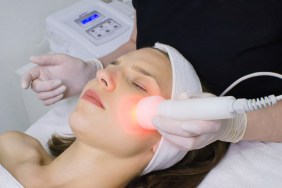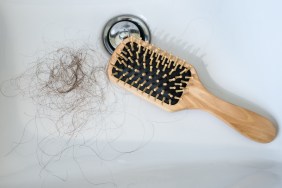Hair Loss Treatments
Treatment should always address the underlying factors that cause the hair loss as well as the immediate appearance of the hair. If hair loss occurs for longer than three months, Kingsley suggests having blood tests. Chronic hair loss can signify an underlying medical condition or imbalance.
“It is important to keep in mind that as hair cells are nonessential, they need higher levels of certain vitamins and minerals in order to reproduce than cells of essential tissue,” says Kingsley. “For instance, a ferritin (iron) reading of less than 80 ug/L can cause hair loss, but it will not damage vital organs. The same applies to vitamin B12 levels. If in doubt, make an appointment to see a trichologist who will be able to analyze your blood tests with the health of your hair in mind. The most common causes of hair loss we see in our clinic are hair loss as the result of breakage, hair thinning due to follicle sensitivity to male hormones, hair loss caused by an unhealthy scalp environment and hair loss from dietary deficiencies and lifestyle. And often a combination of all of these is present.”
Treatment of hair loss as the result of thyroid imbalances, polycystic ovarian syndrome and other long-standing medical conditions can be more complicated — and in these cases you should seek the advice of your doctor. Prescription medications can often be very helpful, but sometimes the medications themselves can be the cause of hair loss.
- “Minoxidil can be a very effective choice for women with genetically driven hair loss,” says Bosley Professional Strength director of education and certified trichologist Michelle Blaisure. Minoxidil (e.g., Rogaine) seems to help slow down the process of hair thinning in some women. It works by improving potassium levels in the capillaries feeding the hair follicle , which sometimes can help to reduce hair shedding. “Researchers do not know all the reasons why minoxidil works, but it helps to increase blood flow and stimulates growth. Remember, however, that it can take at least two months to awaken a dormant hair follicle, leading to new growth,” she adds.
- Hair transplants can be very effective and can also look extremely natural when done by an experienced doctor. According to Blaisure, however, often women are not good candidates as they may not have good donor hair. This can mean that the hair is too weak to withstand the shock of the transplanting process. The good thing is that if you are a good candidate, the new hair is permanent. But only the transplanted areas will benefit. “Other, non-treated areas that are programmed to thin will go on to do so if they are not treated with oral or topical medicaments or are transplanted at a later date,” adds Kingsley.
- Cortisone shots are sometimes given to treat alopecia areata. They suppress your body’s immune system so that it no longer attacks your hair follicles. In certain cases, it can be effective. The treatment can be painful, however, and there is no guarantee it will work.
- “Laser treatments, which are a non-medical service, can be a very effective choice. It works through biostimulation, where the red wavelength light stimulates hair and skin cells through the scalp skin. It must be used several times a week for 15 to 20 minutes at a time and it can take up to two months to start seeing results, You also must continue to use the laser on a maintenance basis in order to maintain results,” says Blaisure. Combining laser treatments with topical products, like Rogaine, often leads to optimal results.
- Finasteride, the generic of the brand-name drug Propecia, is used to prevent hair loss and promote the growth of new hair in men with male pattern baldness. (It’s also used to treat an enlarged prostate gland.) The drug works by preventing the conversion of testosterone to dihydrotestosterone (DHT), which is linked to both BPH (benign prostatic hyperplasia) and male pattern baldness. “Propecia is a DHT blocker, but due to its affect on hormone balance, it can have side effects for women,” warns Blaisure. The FDA strongly cautions women of child-bearing age to avoid the drug, as it could affect the sexual development of a fetus. Other reported adverse reactions are increased body hair, hot flashes, headaches and liver damage.
- Stem cell therapy is still in the experimental stage. “Some doctors are now injecting nutrient and/or stem cells into the scalp, claiming that it can treat hair loss, but again that can be costly for the average woman,” says Blaisure.
- Platelet-rich plasma therapy uses your own blood platelets, a type of blood cell, to stimulate your cells to grow hair. After blood is drawn, the blood is placed into a machine that separates it into its different components. The extracted platelets are then treated and injected into your scalp. Like stem cell therapy, this procedure is still in its infancy.
Hair Masking Solutions
- Invest in a good haircut that will camouflage thinning areas, while giving volume to limp, lifeless strands.
- Thickening sprays and shampoos lightly coat individual hair strands, adding temporary body and bulk. This is usually achieved by adding some type of hydrolyzed protein to the formulation. Kingsley recommends Kingsley Tricho Pro.
- Hair fibers are another easy and quick option to fill in and cover up sparse areas of hair. Try Bosley Professional Strength Hair Thickening Fibers, $30 at Ulta.
- Lastly, wigs are another great solution for concealing hair loss. They’re a great way to experiment with cut, color and length. Customized pieces don’t come cheap (they can cost $1,500 and over), but it’s worth the quality and naturalness they offer.
Your Diet and Your Hair
What you eat can have a profound affect on your hair. An unhealthy diet can often be the sole cause of hair loss. In fact, a deficiency in any vitamin or mineral will usually affect your hair before it affects any other part of the body. This is because hair is a nonessential tissue; yet hair cells are also the second fastest growing cells the body produces. Therefore, any nutrients ingested will first be sent to your vital organs, like your heart, and only if there are enough vitamins and minerals left over will your hair receive them.
Hair is composed primarily of protein; hence, getting your adequate daily intake is necessary in the maintenance of hair growth. Complex carbohydrates are also important since they provide hair with the energy it needs to grow. Iron is similarly vital since the body needs it to produce hair cell protein. But be cautious, too much of a good thing can also do your body harm. “From our research, we have found that eating an excessive amount of mercury-rich foods, such as tuna fish, can cause hair shedding. Excessive vitamin A can have a similar effect,” warns Kingsley.
Where hair loss is the result of a dietary deficiency or ill health, nutritional supplements, alongside changes to the diet, can be an essential part of treatment. Supplements should not be used as a substitute for a healthy diet, though. They should be used alongside a healthy eating plan to give hair extra internal support. Plus, note that not all supplements are created equal. They need to contain the right combination of vitamins/minerals and in the right proportions in order to have maximum benefit. For instance, iron and vitamin C should always be found in a supplement together as your body needs vitamin C to absorb the iron. Being nonessential tissue, hair also needs higher levels of certain nutrients to grow at its optimum rate.
All in all, no matter what the cause of your hair loss, remember to eat a healthy, balanced diet, get your hormone levels and thyroid checked, ask to be tested for iron and zinc levels to rule out underlying medical conditions and use products that encourage a healthy scalp environment to help you maintain and grow a lush, healthy mane. For more over-the-counter products that promote healthy hair or minimize or conceal hair loss, click through our slideshow above.
How To Stop Your Hair From Falling Out
-
Volumizing Spray

“Tricho Pro contains small chain plant proteins, which add immediate body to thinning hair. It also contains antioxidants and lightweight conditioners to reduce hair breakage and improve strength over time,” explains Anabel Kingsley, a Philip Kingsley trichologist.
Philip Kingsley Tricho Pro Volumizing Protein Spray, $64 at Philip Kingsley
-
DHT Inhibitors

This sulfate-free, anti-aging three-step system contains a moisturizing shampoo, a volumizing conditioner and a leave-in treatment, which all are formulated to inhibit DHT, a leading cause of thinning hair.
Bosley Professional Strength BosRevive Kit for Color-Treated Hair, $41.95 at Ulta
-
Rogaine for Women

This easy-to-use hair foam contains a 5 percent minoxidil aerosol solution. Use it once a day to reactivate inactive hair follicles. With continued use, your hair will grow in thicker, longer and stronger.
Women's Rogaine Hair Regrowth Treatment Foam (4 month supply), $39.99 at Drugstore.com
-
Hair Fibers

Keratin fibers attach to strands to plump them up and fill in existing areas of bald patches.
Toppik Hair Building Fibers, $24.95 at Toppik
-
At-Home Laser Device

Wear the laser light therapy helmet twice a week, 20 minutes per session to increase blood flow to the scalp and follicles, which in turn will reduce shedding and stimulate hair growth. Cool feature alert: Audio commands notify the user how many minutes are left in the session, how many total treatments have been completed and when the battery needs recharging.
Theradome LH80 PRO, $895 at Theradome
-
Laser Comb

The HairMax Ultima 12 LaserComb is an FDA-cleared home-use medical device that uses photobiostimulation. Twelve medical-grade lasers deliver the therapeutic light energy directly to your follicles to revitalize them into producing hair by bringing in more oxygen and nutrients. The comb’s hair parting teeth section your hair to ensure the light energy reaches your scalp.
HairMax Ultima 12 LaserComb, $495 at Neiman Marcus
-
Minoxidil Hair Treatment

Formulated with 2 percent minoxidil, this hair treatment helps stimulate the hair follicles into producing new hair growth.
Pantene Pro-V Expert Collection Minoxidil Topical Solution USP, 2% Hair Regrowth Treatment for Women, $29.99 at Drugstore.com
-
Hair Thickening Shampoo

Infused with ginkgo biloba, grapeseed procyanidins and cinchona bark, this revitalizing shampoo stimulates micro-circulation, combats free radicals as well as boosts the volume of your strands.
PHYTO PHYTOCYANE Densifying Treatment Shampoo, $24 at DermStore
-
Stimulating Spray

Neoptide Hair Lotion Spray contains botanicals, vitamins and amino acids that are specially formulated to re-energize your hair bulbs and minimize hair thinning and reduction.
Glytone Neoptide Hair Lotion Spray, $97 at DermStore
-
Hair Pills

This dietary supplement contains AminoMar, an exclusive marine complex, and horsetail extract to fortify hair follicles and boost blood circulation in your scalp, leading to a longer, healthier mane.
Viviscal Extra Strength Dietary Supplements, $49.99 at Viviscal








